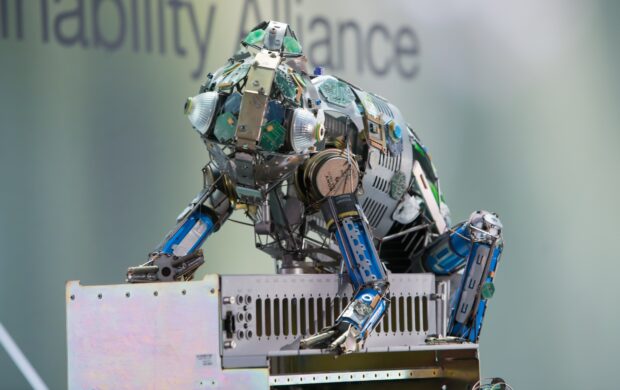https://sustainableict.blog.gov.uk/meet-our-very-own-karma-chameleon/
Meet our very own Karma Chameleon
Forget Culture Club, the E-Waste Chameleon Sculpture goes on tour
The GDSA Summit on Digital Sustainability, held on 20th March 2024, unveiled a chameleon sculpture made from electronic waste as part of the circular economy working group session.
Sculptor Zak Miskry, was commissioned by GDSA members to produce the artwork made from electronic waste to convey a message that we can adapt and innovate, and overcome some global issues linked to tech.
Zak's sculpture was a popular talking point of the day, so to enable as many people as possible to see it and consider what it represents, it has 'gone on tour' to capture people's interest in the issue of electronic waste and the circular economy.
It's hoped the artwork will promote positive conversations, and make us all think about what we can do to reduce our consumption of electronics, and how as both individuals and professionals we can apply principles linked to a circular economy such as more considered purchasing, and proper disposal of technology.
In a circular economy, products and materials are used for longer due to strong maintenance regimes, reuse and refurbishment, remanufacturing and recycling; materials never become waste. The chameleon represents a circular economy, not just because it's made from recycled materials, but because the animal itself is an icon of change and adaptation.
Chameleons have a reputation for evolution and camouflaging to suit their habitats. Depending on the species, chameleons can live in a variety of environments, both on the ground, and in trees, from rainforests, deserts, lowlands and highlands, the chameleon has adapted to live in many different geographical locations.
These habitats are also affected by the tech industry and associated biodiversity loss caused by mineral extraction and climate change.
“Our love affair with technology is encroaching on the actual species habitats.” - Zak Miskry, E-Waste Sculptor & Artist.
But all is not lost; the circular economy working group see the chameleon as representing the ability and need for the tech industry to adapt, to become more sustainable and to evolve, to play a strategic role in enhancing sustainability, meet the UNs SDGs and overcome a wide range of issues within society linked to consumption, use and disposal of tech.
Part of this challenge is recycling and reusability of materials; the e-waste chameleon sculpture uses electronic components that would otherwise be wasted - “Hundreds of waste tonnes of e-waste are being generated each year” – Mimi Moll, IT & Telecoms Sustainability Lead – N2S.
Producing art from electronic waste is a great way to visually represent a solution to our electronic waste problem. But to make a real difference we need to work with industry experts to extract, procure, design, and manufacture with sustainability in mind.
The working group hopes to continue to work collaboratively with experts from fields of product design to end of life recovery to share best practice, challenge issues and make positive steps in circularity.
“In our current economy, we take materials from the Earth, make products from them, and eventually throw them away as waste – the process is linear. In a circular economy, by contrast, we stop waste being produced in the first place” – Ellen MacArthur Foundation.
The circular economy aims to limit climate change and reduce biodiversity loss (protecting chameleons habitats), in part by reducing the consumption of finite resources. Technology uses vast amounts of materials that have to be mined and extracted from our beautiful planet.
The circular economy working group looks at how we can source and design tech that can be used for longer, upgraded, donated or recycled. To find out more about the circular economy working groups activities see our recent blog here...
If the chameleon has inspired you to learn more about the circular economy there's loads of resources out there, from our own Civil Service Learning, various sustainability, engineering and procurement training programmes and online resources.
As a Government we consider the circular economy in our procurement practices, and have created various sustainable procurement polices linked to circularity, we are excited for the working group to help us achieve more in this space.
Mimi Moll is an IT & Telecoms Sustainability Lead at N2S and Zak Miskry is a full time E-Waste Sculptor & Artist.
A summary video of the GDSA summit can be found here.
If you’re interested in finding out more about GDSA or Digital Sustainability, please get in touch.

